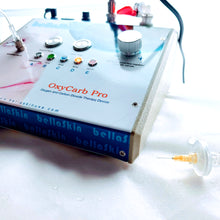CO2 has been proven to effectively tighten the skin and rejuvenate cells, resulting in a notably younger appearance. The OxyCarb is an advanced portable device specifically engineered to inject medical CO2 at a precise flow rate and dosage. It also has the capability to deliver oxygen through a hose connected to a mask worn by the user. The user can easily regulate this flow, ensuring a medical oxygen tank is utilized whenever oxygen is required instead of CO2.
The equipment includes:
- CO2 or oxygen tank (1) aluminum (empty); the customer must choose between CO2 or oxygen regulator with hose
- Sampling line with filter (2)
- Needles (10)
- 12V power supply
- Suitcase for travel
- Clear face masks (sold separately)
**How Does CO2 (Carbon Dioxide) Work?**
Carbon dioxide interacts with water molecules in tissues, forming carbonic acid, effectively lowering the tissue pH. This initiates the Bohr Effect: as the pH decreases, the bond between hemoglobin and oxygen weakens, facilitating the release of oxygen from hemoglobin during carboxytherapy. Additionally, when the pH falls to 6.8 or lower, the permeability of capillary walls increases. At pH levels of 6, 5, or lower, the flexibility of collagen fibers increases while their firmness decreases.
Crucial chemical reactions also occur, including the reduction of divalent calcium ions and the dissociation of carbonic acid into H+ and HCO3-, leading to the formation of calcium hydrogen carbonate (Ca(HCO3)2), sodium hydrogen carbonate (NaHCO3), and potassium hydrogen carbonate (KHCO3).
As a result, the pH shifts to an alkaline state, producing analgesic and spasmolytic effects. The tone of arteries and capillaries decreases, and skin temperature experiences an increase of 1°C. This effect, along with altered nerve activity, significantly boosts the nourishment of the treated areas. Furthermore, the oxidation of fats from fat cells is activated, with research suggesting a direct lipolytic effect on adipocytes. The lungs efficiently exhale the residual CO2. Notably, carboxytherapy is associated with dilation of coronary arteries, bradycardia, and decreased blood pressure.
**How to Apply CO2?**
The application of carbon dioxide in dermatology and aesthetic medicine requires specialized devices. We proudly present BellaCarbo, an innovative device that connects directly to a tank filled with purified CO2 via a reduction valve. The gas operates at a pressure range of 2.5 to 3.5 bar (250,000-350,000 Pa, or 1,875-2,625 Torr). Application parameters, including gas flow in ml/min and total volume in ml, are tailored to the specific indication and area being treated. Injections are performed using a 30G mesotherapy needle that can be 4, 12, or 13 mm in length, with the gas flow controlled via a foot pedal.
The injection angle holds significant importance. For superficial subcutaneous applications, use a 30° angle. This technique elevates the tissue, effectively addressing skin concerns on the face and décolleté, while also improving the appearance of stretch marks.
For deeper intradermal applications, a 45° angle is utilized, making it effective for reducing fatty tissue. Depending on the therapist's expertise and the area being treated, a session typically lasts between 20-40 minutes, with a total volume of applied carbon dioxide ranging from 5-50 ml for the face. In physiotherapy applications, higher volumes of approximately 20-200 ml may be used, with total volumes ranging from 200 to 1,000 ml for the trunk and extremities. It is crucial to avoid injecting into blood vessels to eliminate the risk of hematomas.







